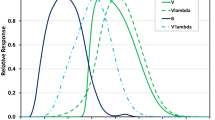Abstract
The Earth’s middle and upper atmosphere is a region exhibiting non-thermal emissions of electromagnetic radiation generally known as airglow. Airglow is a ubiquitous phenomenon and comprises a large number of atomic and molecular emissions in the ultraviolet, the visible and the near-infrared spectral regions. The main purpose of this article is to provide an overview of the basic characteristics of the airglow, the most important airglow emissions occurring in the terrestrial atmosphere—with a focus on nighttime or nightglow emissions—as well as the current scientific understanding of their excitation mechanisms.











Similar content being viewed by others
Notes
Note that the spectral dependence of thermal emissions, e.g., by the liquid or solid parts of the Earth’s surface are well described by Planck’s law. Thermal emissions by atmospheric gases are an exception in this respect, because these emissions can only occur at frequencies, where transitions between different vibrational-rotational levels exist.
The unit of length 1 Ångström = 1 Å = 0.1 nm is named after him.
Neglecting for simplicity the fact that the atmosphere may become opaque, limiting the direct photolytic formation of \(A^*\) at lower altitudes.
References
Clancy RT et al (2013) Icarus 226:272
Piccioni G et al (2008) Astron Astrophys 483:L29
Slanger TG, Cosby PC, Huestis DL, Bida TA (2001) Science 291:435
Herse M, Rigaud P (1985) Can. J. Phys. 63:1446
Shepherd GG, Cho YM (2017) Geophys Res Lett 44. doi:10.1002/2017GL074014
Picone JM, Hedin AE, Drob DP, Aikin AC (2002) J Geophys Res Space Phys 107(A12):1468. doi:10.1029/2002JA009430
Chamberlain JW (1961) Int Geophys Ser 2:722 (Academic Press)
Wayne RP (2000) 3rd edn. Oxford University Press, Oxford, p 806
Khomich VY, Semenov AI, Shefov NN (2008) Springer. doi:10.1007/978-3-540-75833-4
Slanger TG, Copeland RA (2003) Chem. Rev. 103:4731
Angstrom JA (1869) Pogg. Ann. 137:161
McLennan JC, Shrum GM (1925) Proc R Soc (London) A 108:501
Slipher VM (1929) Publ Astron Soc Pac 41:262
Chapman S (1939) Astrophys J 90:309
Meinel AB (1950) Astrophys J 112:120. doi:10.1086/145321
Espy PJ, Stegman J (2002) Phys Chem Earth 27:543
Offermann D, Hoffmann P, Knieling P, Koppmann R, Oberheide J, Steinbrecht W (2010) J Geophys Res 115:D18127. doi:10.1029/2009JD013363
Shepherd GG et al (1993) J Geophys Res 98:10,725. doi:10.1029/93JD00227
Burrows JP, Hoelzle E, Goede APH, Visser H, Fricke W (1995) Acta Astronautica 35:445
Bovensmann H, Burrows JP, Buchwitz M, Frerick J, Noel S, Rozanov VV, Chance KV, Goede APH (1999) J Atmos Sci 56(2):127
von Savigny C, McDade IC, Eichmann KU, Burrows JP (2012) Atmos Chem Phys 12(18):8813
Lednyts’kyy O, von Savigny C, Eichmann KU, Mlynczak MG (2015) Atmos Meas Tech 8:1021. doi:10.5194/amt-8-1021-2015
von Savigny C, Langowski M, Zilker B, Burrows JP, Fussen D, Sofieva VF (2016) Geophys Res Lett 43. doi:10.1002/2016GL071313
Mlynczak MG, Solomon S, Zaras DS (1993) J Geophys Res 98(D10):18,639
Baker DJ, Stair AT (1988) Phys. Scr. 37:611
von Savigny C (2015) J Atmos Sol Terr Phys 127:120
French WJR, Klekociuk AR (2011) J Geophys Res 116:D00P09. doi:10.1029/2011JD015731
Pendleton WR Jr, Espy PJ, Hammond MR (1993) J Geophys Res 98(A7):11567. doi:10.1029/93JA00740
Cosby PC, Slanger TG (2007) Can J Phys 85:77. doi:10.1139/P06-088
Noll S, Kausch W, Kimeswenger S, Unterguggenberger S, Jones AM (2015) Atmos Chem Phys 15:3647. doi:10.5194/acp-15-3647-2015
Slanger TG, Cosby PC, Huestis DL, Saiz-Lopez A, Murray BJ, OSullivan DA, Plane JMC, Prieto CA, Martin-Torres FJ, Jenniskens P (2005) J Geophys Res 110:D23302. doi:10.1029/2005JD006078
Plane JMC, Oetjen H, de Miranda M, Saiz-Lopez A, Gausa M, Williams B (2012) J Atmos Sol Terr Phys 74:181
Acknowledgements
We are indebted to the European Space Agency (ESA) for providing SCIAMACHY Level 1b data. SCIAMACHY is jointly funded by Germany, the Netherlands and Belgium. Work on the oxygen airglow at Ernst-Moritz-Arndt-University of Greifswald is in part funded by Deutsche Forschungsgemeinschaft (DFG) through Grant SA 1351/6-1. Work on the Na nightglow retrievals is in part funded by ESA (project MesosphEO) and DFG (Grant SA 1351/8-1). Work on the OH nightglow is funded by BMBF (Bundesministerium für Bildung und Forschung) through ROMIC (Role of the Middle Atmosphere in Climate) project OHCycle.
Author information
Authors and Affiliations
Corresponding author
Rights and permissions
About this article
Cite this article
Savigny, C.v. Airglow in the Earth atmosphere: basic characteristics and excitation mechanisms. ChemTexts 3, 14 (2017). https://doi.org/10.1007/s40828-017-0051-y
Received:
Accepted:
Published:
DOI: https://doi.org/10.1007/s40828-017-0051-y




